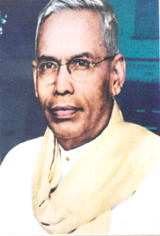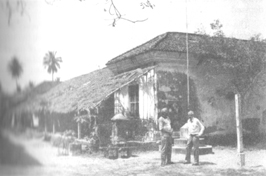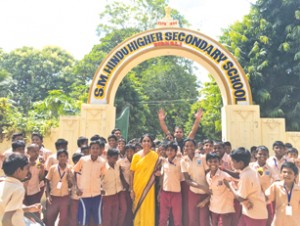Registered with the Registrar of Newspapers for India under R.N.I 53640/91
Vol. XXV No. 18, January 1-15, 2016
The Maths Prof. who became a librarian
Chandra Sri Ram, a grand-niece of S.R. Ranganathan, the legendary librarian, recalls him after a visit to Sirkazhi, where he was born and did his early education.
Almost every city, town and village in the world has one. Certainly every university and almost every school.
Every middle class family slowly builds one, and for many it is displayed with pride. The library is now, if not ubiquitous, at the very least regarded as the sine qua non of developing any community, or the functioning of any school, institute of higher learning or professional organisation.
Yet, it is easy to forget that the concept of the library is almost as ancient as the written word itself, and remained almost unchanged until the mid-20th Century, when the science of classifying information underwent a remarkable transformation. At its helm was the person quite rightly regarded as the father of Library Science (who actually coined the term “Library Science”), and my grand-uncle, Dr. S.R. Ranganathan.
Much has been written about Ranganathan’s professional achievements in the field of Library Science in books, encyclopaedias and research papers. However, little is commonly known about his personal life and the many tragedies that he had to overcome to achieve what he did. That he was able to leave such an indelible mark in his field against such odds serves as a salutary lesson of the tremendous rewards that hard work, patience and single-minded focus can bestow even in the face of grave odds.
* * *
 S.R. Ranganathan
S.R. Ranganathan
Sirkazhi Ramamrita Ranganathan was born in Sirkazhi to Ramamrita Iyer and Sitalakshmi on August 12, 1892. He spent his infancy with his parents in the hamlet of Ubhayavedantapuram in the then Tanjore District of the Cauvery Delta. When he was hardly six years old, tragedy first struck. His father, Ramamrita, took seriously ill with cholera and passed away. Ramamrita’s wife Sitalakshmi was expecting their third child. That posthumous girl child was my paternal grandmother, Aviambal. Ranganathan was all at once left with a young widowed mother, a brother and a posthumous sister.
As there were no formal schools in Ubhayavedantapuram at that time, Ranganathan’s uncle (his mother’s elder brother), Kalyana, enrolled him in 1897 in the Sabhanayaka Mudaliar Hindu Higher Secondary School in Sirkazhi where Sitalakshmi was from. Ranganathan got his primary and secondary education, from the “3Rs” right up to Matriculation, from this institution, something he never forgot. The school celebrated its centenary in 1996 and is still going strong. Its enrolment had grown from 155 in 1898 to 3,642 in 1995 of which 968 were girls.
When Ranganathan competed his schooling at the Sabhanayaka School in 1907, at age 17, he was sent to Madras to join Madras Christian College. There he completed his B.A. degree in Mathematics.
 The old school building, Sirkazhi, 1999. It is still in use for some primary classes.
The old school building, Sirkazhi, 1999. It is still in use for some primary classes.
Both in his home village of Ubhayavendantapuram as well as in Sirkazhi, Ranganathan grew up in the atmosphere of an orthodox Ayyar family where he must have had little or no contact with persons outside the Brahmin communities. When he was barely 15, Ranganathan married Rukmani, who was then 11 years old.
In Madras, Ranganathan was exposed to a more cosmopolitan society. Students of different religious faiths and social traditions attended the college. The teaching staff was even more pluralistic in its background, many of them British! Since he lived in the hostel, this exposure was not restricted only to class hours.
* * *
It was during these student years in Madras that Ranganathan established a close personal relationship with his Mathematics teacher, Professor Edward B. Ross, a Scott by birth. This relationship was more in the Upanishadic pattern of teacher-disciple, rather than of the usual professor-student type. Professor Ross taught Ranganathan during his B.A. course and was Ranganathan’s mentor, intellectual guide and even provided fatherly help at crucial periods until he left Madras for good on retirement. Ranganathan was nearing 40 by then. Ross and Ranganathan remained in contact until the former’s death.
Ranganathan in his autobiography A Librarian Looks Back narrates this anecdote, which speaks volumes of the person that Professor Ross was. When Ranganathan completed his B.A. degree he told Ross that he would now look for an employment opportunity. Apparently Prof Ross was stunned. He had expected Ranganathan to continue his studies to get a Master’s degree. Ranganathan explained to Ross that apart from a widowed mother, he had a sister and brother to look after. Further, he had to also start his own conjugal life with Rukmani, his wife still only by contract. He told Ross that there were no financial means available to enable him to pursue further studies.
Prof. Ross was of a different opinion. He found that Ranganathan had more in him than to be a mere wage-earner for the upkeep of a household, and thought that he should do an MA course in Mathematics. As he told Ranganathan, “God will make sure that the wherewithal will be forthcoming.” It was a dictat, and Ranganathan had no choice but to enrol himself in the Master’s course. Professor Ross paid his admission fees.
On the first day of the month following his admission, Ranganathan found a gold sovereign under his pillow in the hostel. Thereafter, on the first day of every month for the duration of his MA studies, he found a gold sovereign under his pillow. Ranganathan could not easily trace the source of this monthly bounty, though he concluded that it must have been Ross.
When Ranganathan became Madras University’s first full-time professional librarian in 1925, he used the salary increase that came with his new post to institute the Professor Ross Endowment for Mathematics at Madras Christian College.
* * *
With the blessings and encouragement of Ross, Ranganathan got involved in the activities of the Indian Mathematical Society founded by Prof. V. Ramasamy Ayyar. Prof. Ayyar was a Deputy Collector by profession with a passion for Mathematics. While Ross was instrumental in the development and application of Ranganathan’s intellectual potential, VR Ayyar was the person who converted Ranganathan’s mental outlook from passive acceptance to active creativity.
 S.M. Hindu Higher Secondary School, Sirkazhi, as seen by the author today.
S.M. Hindu Higher Secondary School, Sirkazhi, as seen by the author today.
VR Ayyar first met Ranganathan at the first All India Conference of the Indian Mathematical Society held in Madras in 1916. Ranganathan, who was then 24 years old, had submitted two papers, one of which was accepted for presentation. It dealt with the subject of ‘Indian Mathematics’. He evidently had the urge to be creative but lacked self-confidence, which was no doubt due, at least in part, to his stammer, which became more acute when he was excited or under mental stress. It takes courage to push through under such circumstances. Ranganathan found that courage with the help of the Chairman of the Conference and delivered the paper despite having a momentary black out.
Just when Ranganathan thought that he had made a fool of himself he heard the prolonged applause which followed his address and rushed out of the room, still in a state of fright. He turned to see the huge frame of VR Ayyar, who had followed him out of the room. He clasped Ranganathan’s hands strongly and told him in crisp words, accompanied by a smile, “Very good, very, very good. I am glad that young India is coming up.” From that day until his death in 1935, VR Ayyar remained deeply attached to Ranganathan and his family.
* * *
At this point it is worth noting that it was Prof. VR Ayyar who first interviewed the mathematical genius Srinivasa Ramanujan for the position of a clerk. Ramanujan that that time was under much pressure from his family to find employment. During the interview, Ramanujan showed VR Ayyar one of his notebooks with the results that he had found. VR Ayyar told him that he would lose his mathematical talent if he worked as a clerk. Instead, he gave a letter of recommendation to the distraught Ramanujan to take to Professor Seshu Ayyar who in turn recommended Ramanujan to the then President of the Mathematical Society. The rest is history.
The connection between Ranganathan and Ramanujan does not end there. He was Ranganathan’s idol and, in 1967, Ranganathan authored one of the leading biographies on Ramanujan titled Ramanujan, the Man and the Mathematician, which is quoted scores of time in Robert Kanigel’s well-known biography on Ramanujan, The Man who knew Infinity (1991).
* * *
After working three years as an Assistant Professor of Mathematics at Presidency College, Ranganathan was appointed the first Librarian of the University of Madras.
In 1923 came the most dramatic turning point in Ranganathan’s professional life which led eventually to the discovery of what would become his life’s work. Ranganathan was a member of a negotiating team of the Indian teaching staff seeking better pay at Presidency College. They were paid only about 10 per cent of what an Englishman got for the same job. The mission was unsuccessful. They were told that if they sought better income, they should change their field of activity.
It was therefore to make both ends meet that Ranganathan applied for a new post that had been advertised with a great improvement in pay and status. The University was looking for someone to be its first full-time librarian. More by the cajoling of his colleagues than by his own keenness, he had applied for the job, sending the papers in on the very last day. He was not sure whether he had done the right thing in applying for the post. He would have to quit his favourite subject of Mathematics and would also have to give up teaching.
His appointment orders reached him on January 4, 1924. On that day Ranganathan became the first ever librarian of the University of Madras. His initial weeks at the new job only made him bored and frustrated. He felt he was no more than a glorified storekeeper of dingy and dusty documents, which nobody was interested in.
The so-called University Library was located in the Connemara Museum complex, sharing the main hall with the Public Library. It was about as far removed from the city’s colleges as you could imagine and was poorly accessible by public transport. Eight months of sticking it out brought him welcome news: he was to report to the UK to receive his formal education and training in librarianship.
(To be concluded)

